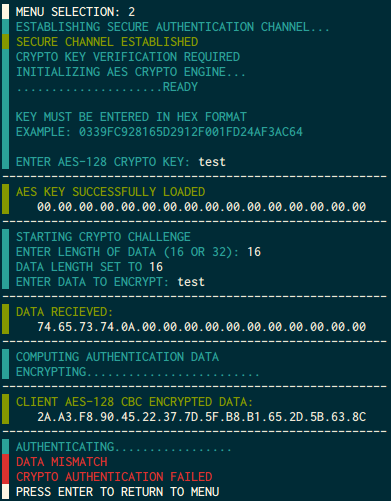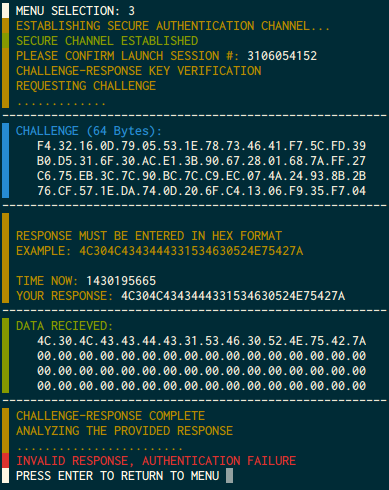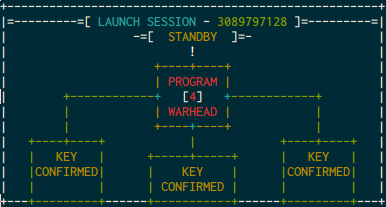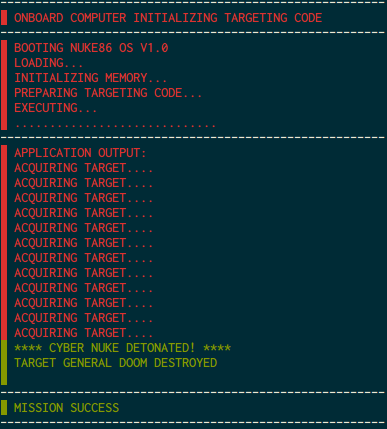rpisec_nuke binary exploitation writeup
This semester at RPI I’m taking the class “Modern Binary Exploitation”. This post will detail how I reversed and cracked the rpisec_nuke binary.
Understanding rpisec_nuke
Running the binary shows us 3 options, KEY 1, KEY 2, and KEY 3

KEY 1 is seemingly the most simple, it asks us for a launch key, and then
tries to authenticate with that.

KEY 2 looks more complicated, it askes us for an ‘AES-128 CRYPTO KEY’,
a data length, and the data to encrypt.

KEY 3 is presumably to be the most complicated. it starts by asking us to
confirm the launch session, which is found at the top of the banner, then it
gives us a challenge and asks for a response.

Unlocking KEY 1
After some time in IDA I found a fantastically simple bug that lets us get through all the authentication steps. If I input null bytes then it stops reading with length 0, with this the strncomp passes since all of the ( zero ) characters were matches.
Unlocking KEY 2 and determining PRNG
After spending a bunch of time in IDA looking through two, I couldn’t find the vuln. I gave up and went to key three. The first thing I noticed is that if you fail the launch session on the first time you open three it frees that struct on the WOPR. In GDB I could see that going back into two after this occurance causes it to allocate the struct right on top of where three’s free’d one was. If I enter in garbage on two and then go back to three the challenge that I see will contain the password for two xor’d with random integers.
The first step here was to figure out the prng seed. It was easy to find using IDA that it was seeded with the current time, and since in key three they give us the time of access we can use this as a reference point. If I just enter new lines during key two then when I get the key three, the first line of the challenge after uxoring should be
0a00000000000000000000000000000000I wrote a loop to keep trying times lesser than the time output in key three until it was able to unxor to this value. Once I had this I knew the prng seed and could take advantage of any random numbers in the program. I also used this seed to unxor key two which gave me the password in plain text :) Entering this key in unlocks the level.
key2 = 4e96e75bd2912e31f3234f6828a4a897Unlocking KEY 3
At this point I can guess random numbers. I spent some time looking at what the challenge actually does: Each time you open key three it xors the challenge with random numbers, then xors the diagonal 4 bytes at a time with 4 bytes of the password. when it checks your challenge it does the same thing agian. since I already can undo the random number xor, figuring out the password was as simple as unxoring the random numbers.
key3 =
90357303000000000000000000000000
00000000412ef8220000000000000000
0000000000000000cd10e79800000000
000000000000000000000000760491a6To unlock the level I simple xor the challenge with the next 16 random numbers and also with the block above.

Programming Nuke86
The first thing I see when pressing the almighty 4 is a prompt asking me for the targetting code. After I give my input nuke86 tells me the checksum and then fails. The first thing to do is to figure out how to pass this step. In IDA I see that the checksum is compared against the xor of all three key flags which represent whether or not you have unlocked that key.
checksum = 0xCAC380CD ^ 0xBADC0DED ^ 0xACC3D489
checksum = 0xDCDC59A9Also in the compute_checksum function I see that the checksum is just the composite of my input xor’d 4 bytes at a time. I played around with my input until I was able to get it to match 0xDCDC59A9 This showed me “PROGRAMMING COMPLETE”. When I then type launch it shows me mission failed shutting down, etc. Now it’s time to really learn how to program this thing.
In IDA launch_nuke reveals the “programming language” used by nuke86. Here’s a mapping of the instructions:
R = Reprogram Nuke
D = Compare to DOOM and DISARM, if DOOM then detonate, if DISARM, then disarm.
E = Compare to END, end the program.
I = Increment the "program pointer"
O = Output the "Targetting status code" which is relative to where the "program pointer" is
S = Set the character at the "program pointer" to the next characterWith this it’s very easy to write a program to detonate on general doom, just use S and I to write it in, then type DOOM to blow it up

The exploit was pretty trivial to find, if I just keep typing I, then the “program pointer” goes way overboard and gives me write access to the function pointers in the struct namely the detonate_nuke pointer. So I can just I until I’m there, then put in my rop chain and DOOM to detonate. I tested this using strace to see if I can set the real program pointer to 0x41414141 and I was successful.

Since I already have a pointer to the WOPR I can just use that to point to where /bin/sh is input within the nuke86 program, and all I have to do is put in my rop chain after I do all my offsetting with I. I did not actually do the rop chain but I have a high suspicion that it will be the same execve setup that we’ve done many times.
My Auth Program can be found here: auth.py
My Key2 && Key3 inital finders can be found here: keys.py